Success is often defined differently depending on the context, whether it’s personal achievements, professional milestones, or academic excellence. A common misconception permeates our society: that constant work and relentless effort are the primary routes to success. However, what if the key to achieving long-term success lies not in working harder but in resting more? This article explores how rest can be the secret ingredient that fuels enduring achievement.
The Science of Rest
Understanding the science behind recovery reveals why it is essential for optimal performance and long-term success. Numerous studies highlight the physiological and psychological benefits of taking time to recuperate, showing that such practices can lead to enhanced productivity and overall well-being.
Overview of Research on Recovery and Productivity
Research consistently indicates a strong correlation between rest and increased productivity. For instance, studies published in journals like Sleep and The Journal of Occupational Health Psychology have shown that employees who take regular breaks are more focused and efficient than those who work non-stop. One study found that taking breaks every 90 minutes can lead to a 30% increase in productivity. This phenomenon is often referred to as the “Ultradian Rhythm,” suggesting that our bodies naturally cycle through periods of focused attention followed by the need for recovery.
The Role of Sleep
Sleep is perhaps the most critical form of recovery. During sleep, the brain undergoes various processes essential for cognitive functions, such as memory consolidation, emotional regulation, and problem-solving. The National Sleep Foundation recommends 7-9 hours of sleep for adults to achieve optimal health and performance. Research indicates that lack of sleep can lead to impaired cognitive function, increased stress, and heightened emotional reactivity. For example, studies have shown that sleep-deprived individuals perform worse on tasks requiring attention and decision-making compared to those who are well-rested.
Types of Recovery
- Sleep: Quality sleep is foundational for both mental and physical health. The human body chooses deep sleep to perform tissue repairs as well as create proteins and emit growth hormones. The brain develops enhanced cognitive clarity through its nightly removal process of daily toxin accumulation.
- Brief work breaks which are planned effectively increase both creative output and focus ability among employees.. Techniques such as the Pomodoro Technique, which involves working for 25 minutes followed by a 5-minute break, have been shown to improve concentration and reduce mental fatigue. Research indicates that these brief pauses can rejuvenate the mind, allowing for better performance.
- Leisure activities combined with vacations offer people a temporary break from work stress through hobbies and recreation. stress. Studies show that people who take regular vacations report lower levels of stress and greater life satisfaction. Leisure activities stimulate the brain in different ways, often leading to renewed inspiration and creativity.
- Mental Recovery: Techniques such as mindfulness and meditation can significantly impact overall well-being. Research published in Psychological Science indicates that mindfulness practices can improve attention, reduce anxiety, and enhance emotional regulation. These practices allow individuals to clear their minds, leading to greater clarity and focus upon returning to work tasks.
Long-Term Benefits of Adequate Recovery
Sufficient recuperation produces long-lasting advantages which exceed momentary work productivity increases. Consistent recovery can lead to improved mental health, reduced risk of burnout, and better physical health outcomes. Studies have shown that individuals who prioritize these practices experience lower levels of anxiety and depression. Furthermore, a well-rested individual is more likely to engage in healthy behaviors, such as exercise and balanced eating, creating a positive feedback loop that enhances overall well-being.ore likely to engage in healthy behaviors, such as exercise and balanced eating, creating a positive feedback loop that enhances overall well-being.

The Benefits of Rest
Rest is not just a passive state; it serves as a crucial component for achieving peak performance in various aspects of life. Here’s a deeper look into the specific benefits of rest:
Enhanced Creativity
Rest fosters innovative thinking and problem-solving capabilities. When we allow our minds to disengage from constant demands, they can wander freely. The mental space creates situations that produce unpredictable associations between ideas along with new insights. Many celebrated artists including Thomas Edison together with Salvador Dalí have pointed to relaxation phases or daydreaming as the sources of their most groundbreaking ideas. Idea development through subconscious processes happens throughout periods of relaxation which scientists call “incubation effect.”
Improved Decision-Making
Being fatigued impairs proper judgment while causing decisions to become less effective. When individuals are overworked, their cognitive resources are depleted, making it challenging to weigh options and foresee consequences. Research shows that well-rested individuals are more adept at making rational, informed decisions. For instance, studies involving executives demonstrate that those who prioritize rest are better at strategic planning and risk assessment, ultimately leading to improved organizational outcomes.
Better Physical Health
Rest is essential for maintaining overall physical health. Chronic sleep deprivation and stress can contribute to a host of health issues, including obesity, diabetes, cardiovascular disease, and weakened immune function.Through rest the body has the essential time to do self-repairing while controlling hormonal balances and managing metabolic processes. Furthermore, research indicates that individuals who prioritize rest experience lower levels of stress hormones like cortisol, contributing to a healthier lifestyle.
Increased Motivation and Energy
Rest serves as a vital recharge for both mental and physical energy. When individuals take the time to recuperate, they return to their tasks with renewed vigor and enthusiasm. This increase in energy not only enhances productivity but also fosters a positive outlook, reducing feelings of burnout and fatigue. Multiple professionals state that distributing brief interspersed work breaks daily leads to continued motivation together with enhanced job contentment.
Enhanced Learning and Retention
For students and lifelong learners, rest plays a critical role in consolidating information. Research indicates that sleep, in particular, strengthens neural connections related to memory, enhancing the retention of newly acquired knowledge. Techniques such as spaced repetition, which incorporates rest intervals between study sessions, have been shown to improve long-term retention and understanding of material.
Emotional Well-Being
Rest contributes significantly to emotional health. Lack of rest can lead to irritability, anxiety, and mood swings. By contrast, regular periods of rest and relaxation can improve mood, enhance resilience to stress, and promote emotional stability. Practices such as mindfulness and meditation, which encourage mental rest, have been linked to reduced symptoms of anxiety and depression, further underscoring the importance of incorporating rest into daily routines.
Better Relationships
Rest not only benefits individuals but also enhances interpersonal relationships. When people are well-rested, they tend to communicate more effectively and exhibit greater empathy and understanding. This improved emotional state fosters better collaboration and teamwork, whether in professional environments or personal relationships. As a result, prioritizing rest can lead to healthier, more fulfilling interactions with others.
Rest in Different Contexts
Rest is a universal need that manifests differently across various settings and activities. Understanding how to incorporate rest effectively in different contexts can significantly enhance productivity, performance, and overall well-being.
In the Workplace
The modern workplace is increasingly recognizing the importance of rest. Companies that foster a culture of breaks and downtime often experience higher employee satisfaction and productivity. Here are some ways rest is integrated into the workplace:
- Flexible Work Hours: Many organizations are adopting flexible schedules that allow employees to choose when they work best. This flexibility can lead to better work-life balance and reduced burnout.
- Nap Rooms: Some companies, like Google and Zappos, have incorporated nap rooms or quiet spaces where employees can take short naps to recharge. Research shows that even a brief nap can enhance alertness and cognitive function.
- Mandatory Break Policies: Forward-thinking companies are implementing policies that require employees to take regular breaks. This can include lunch breaks, coffee breaks, or even time away from screens to promote mental well-being.
- Wellness Programs: Many organizations offer wellness initiatives that include mindfulness sessions, yoga classes, or stress-management workshops, encouraging employees to prioritize their mental health through structured rest.
For Students
Rest is equally critical for students, especially during high-pressure periods such as exams or project deadlines. Here are some effective strategies for incorporating rest into a student’s routine:
- Breaks During Study Sessions: Techniques like the Pomodoro Method, studying for 25 minutes followed by a 5-minute break, can enhance focus and retention. This method not only allows for mental recovery but also helps to maintain motivation.
- Sleep Hygiene: Establishing good sleep habits, such as a consistent sleep schedule and a conducive sleeping environment, is crucial for students. Quality sleep enhances memory consolidation and cognitive function, which are vital during intense study periods.
- Active Leisure: Encouraging students to engage in physical activities or hobbies during study breaks can provide a refreshing change of pace, reducing stress and promoting overall well-being.
- Peer Collaboration: Group study sessions can incorporate structured breaks, allowing students to rest and socialize, which can enhance learning and reduce feelings of isolation.

For Athletes
In the realm of athletics, understanding the importance of rest is paramount for optimal performance and injury prevention. Here’s how rest plays a crucial role for athletes:
- Structured Recovery Plans: Athletes often follow training regimens that include designated rest days or lighter training sessions. These recovery periods allow muscles to repair and grow stronger, which is essential for performance improvement.
- Sleep and Performance: Research highlights that sleep is a critical factor for athletic performance. Adequate sleep improves reaction times, endurance, and overall physical performance. Athletes are encouraged to prioritize sleep as part of their training.
- Mindfulness and Mental Recovery: Techniques such as mindfulness and visualization can help athletes mentally disengage from the pressures of competition, allowing them to return to training with renewed focus and determination.
- Nutrition and Hydration: Proper nutrition and hydration are integral to recovery. Athletes are encouraged to consume balanced meals and fluids after workouts to facilitate physical recovery, further emphasizing the connection between rest and performance.
In Creative Fields
For those in creative professions, rest is a vital ingredient for inspiration and innovation. Here’s how rest benefits creative individuals:
- Unstructured Time: Allowing time for unstructured activities, such as daydreaming or engaging in hobbies, can lead to unexpected bursts of creativity. This is often when the mind makes unique connections and generates original ideas.
- Artistic Retreats: Many artists and writers benefit from retreats that provide dedicated time and space for relaxation and creative exploration. These environments often encourage rest as part of the creative process.
- Collaborative Breaks: In creative teams, taking breaks together can foster camaraderie and spark new ideas. Casual conversations during downtime can lead to collaborative breakthroughs that wouldn’t occur in a high-pressure environment.
In Everyday Life
In our daily lives, rest can be seamlessly integrated into routines to enhance overall well-being:
- Mindful Living: Incorporating mindfulness practices, such as meditation or deep-breathing exercises, into daily life can provide mental rest and promote emotional balance.
- Digital Detox: Limiting screen time and taking breaks from technology can help reduce mental clutter and improve concentration. This detox can involve setting boundaries for social media usage or designating tech-free times during the day.
- Quality Time with Loved Ones: Spending time with family and friends can serve as a restorative practice. Engaging in meaningful conversations or shared activities allows individuals to recharge emotionally and socially.
Overcoming Barriers to Rest
Despite the clear benefits of rest, many individuals face significant barriers that prevent them from incorporating adequate downtime into their lives. Understanding these barriers is the first step toward overcoming them and establishing a healthier approach to work and productivity.
Cultural Attitudes Towards Work and Rest
- The Stigma of Taking Breaks: In many cultures, particularly in high-pressure environments, there is a pervasive stigma associated with taking breaks. People may feel guilty for stepping away from work, fearing it reflects a lack of commitment or productivity. This mindset can lead to a cycle of overwork and burnout, as individuals neglect their need for rest in favor of constant activity.
- The “Hustle” Mentality: The glorification of the “hustle” culture promotes the idea that constant work and relentless effort are essential for success. This mentality can create unrealistic expectations, leading individuals to believe they must always be busy to achieve their goals. As a result, taking time to rest may be viewed as a weakness rather than a necessary component of success.
- Comparative Pressure: In workplaces or social circles where others are constantly working and achieving, individuals may feel pressured to match that level of intensity. The fear of falling behind can discourage them from prioritizing rest, even when they recognize its importance.
Practical Tips for Incorporating Rest
- Scheduled Breaks: One effective way to overcome the barriers to rest is to implement scheduled breaks throughout the day. By setting specific times for short breaks, individuals can create a routine that normalizes rest. For example, using techniques like the Pomodoro Technique can help structure work and rest intervals, making it easier to step away from tasks without guilt.
- Mindfulness Techniques: Incorporating mindfulness practices into daily life can promote mental rest and clarity. Simple techniques such as deep breathing exercises, meditation, or even short walks can help individuals recharge during the day. These practices can be integrated into breaks, making them more intentional and beneficial.
- Setting Boundaries: Establishing clear boundaries between work and personal life is crucial for prioritizing rest. This may involve setting specific work hours, turning off notifications after hours, or designating a separate workspace. Communicating these boundaries with colleagues and family members can foster a supportive environment that encourages rest.
- Creating a Rest-Friendly Environment: Designing a space that promotes relaxation can make it easier to embrace rest. This might include creating a comfortable area for breaks, incorporating plants or calming colors, or having tools for relaxation, such as books, music, or art supplies. A restful environment can signal to the mind and body that it is time to unwind.
- Reevaluating Success Metrics: Shifting the focus from constant busyness to quality of work can help alleviate the pressure to avoid rest. Individuals can redefine success to include balance and well-being, recognizing that taking breaks can ultimately enhance performance and creativity.
Encouraging a Rest Culture
- Workplace Initiatives: Organizations can play a significant role in promoting a culture that values rest. Implementing policies that encourage breaks, such as flexible work hours, designated relaxation spaces, and mandatory vacation days, can help employees feel empowered to prioritize their well-being.
- Leadership Support: Leaders and managers should model healthy work-life balance practices. When leaders openly take breaks, prioritize their own rest, and encourage their teams to do the same, it creates an environment where rest is valued and normalized.
- Community Awareness: Raising awareness about the importance of rest within communities can help shift cultural attitudes. Workshops, seminars, and campaigns that highlight the benefits of rest can empower individuals to prioritize their well-being and challenge the stigma associated with taking breaks.
Conclusion
In conclusion, rest is not merely a luxury but a necessity for long-term success. By recognizing the importance of rest and incorporating it into our daily lives, we can enhance our creativity, decision-making abilities, physical health, and overall motivation. It’s time to shift our mindset and prioritize rest as a fundamental component of a successful life.

